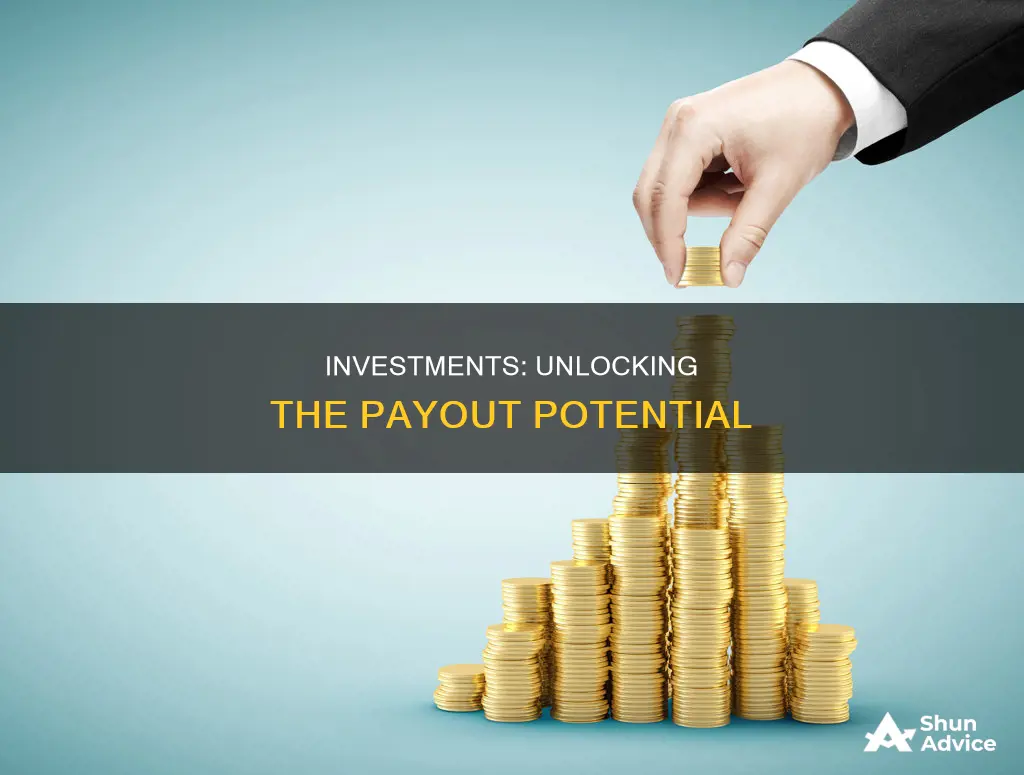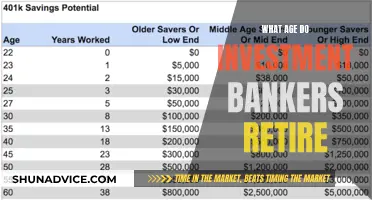
Payouts refer to the expected returns or disbursements from investments. They can be expressed as a lump sum or on a periodic basis, and as either a percentage of the investment's cost or in a real dollar amount. Dividends are regular payments of profit made to investors who own a company's stock.
Dividends can be paid in cash or in shares of stock. In most cases, companies that pay dividends to shareholders do so quarterly. However, some companies may pay dividends monthly, semi-annually, or annually. Dividend-paying stocks provide a way for investors to get paid during rocky market periods and can help build wealth over time through reinvestment.
When deciding on an investment, it's important to consider the dividend yield, dividend per share, and the dividend payout ratio. The dividend yield tells you the percentage of a company's share price paid out in dividends. Dividend per share refers to how much a company distributes in dividends for each share of outstanding stock. The dividend payout ratio illustrates how much of a company's net income goes toward dividend payouts.
| Characteristics | Values |
|---|---|
| Definition | A payout is the share of profits that a listed company will pay its shareholders. |
| Forms | A payout can be expressed as a lump sum or on a periodic basis and as either a percentage of the investment's cost or in a real dollar amount. |
| Time | A payout can also refer to the period in which an investment or project is expected to recoup its initial capital investment and become minimally profitable. |
| Payout ratio | The payout ratio is the rate of income paid out to investors in the form of distributions. |
| Dividends | Dividends are regular payments of profit made to investors who own a company's stock. |
| Dividend stocks | Dividend stocks can provide a stream of income. |
What You'll Learn
- Dividends: regular payments of profit made to investors who own a company's stock
- Payouts: expected returns or disbursements from investments
- Non-retirement investments: investments that are not in a retirement account
- Payout ratio: the rate of income paid out to investors in the form of distributions
- Capital budgeting: a tool used to determine the number of years it takes for a project to pay for itself

Dividends: regular payments of profit made to investors who own a company's stock
Dividends are regular payments made by companies to investors who own the company's stock. They are a way of sharing profits with investors and are usually paid out in cash. Dividends are typically paid out quarterly, but they may also be paid out monthly, annually, or on a one-off basis. The amount paid out in dividends is decided by the company's board of directors and is usually based on the company's recent earnings. Dividends provide a stream of income for investors and can boost their returns over time.
The process of paying dividends usually involves the following steps:
- Declaration Date: The company's board of directors announces their intention to pay a dividend.
- Ex-Dividend Date: Investors must purchase shares before this date to qualify for the upcoming dividend.
- Record Date: The company determines which shareholders are invested and thus entitled to the dividend.
- Payment Date: The dividend is paid out and deposited into the investors' accounts.
It is important to note that not all companies pay dividends. Some companies, especially young and fast-growing companies, may choose to reinvest their profits back into the business instead of paying dividends. Dividend-paying companies are usually larger, established companies with predictable profits.
Dividends can also be issued as shares of stock, although this is less common. Dividend payments may be subject to income tax, depending on the investor's income level and the tax laws in their jurisdiction.
Overall, dividends provide a way for companies to reward their shareholders and attract long-term investment. They are an important aspect of investing and can offer a steady source of income for investors.
China's Bubble: Global Investment Risk
You may want to see also

Payouts: expected returns or disbursements from investments
Payouts refer to the expected returns or disbursements from investments. They can be expressed as a lump sum or on a periodic basis, such as monthly or quarterly, and as a percentage of the investment's cost or in a real dollar amount.
In the case of financial securities like annuities and dividends, payouts refer to the amounts received at specific intervals. For example, with annuities, retirees receive payments from the insurance company as income at regular intervals, such as monthly or quarterly.
The term "payout" is also used to describe the period in which an investment or project is expected to recoup its initial capital outlay and turn a minimal profit. This is often referred to as the "time to payout," "term to payout," or "payout period."
The payout ratio is another important concept. It represents the rate of income paid out to investors in the form of distributions, such as dividends or share buybacks. A payout ratio of 20% means the company distributes 20% of its profits to shareholders.
When it comes to shareholder remuneration, a payout is the proportion of profits that a listed company will pay to its shareholders. For example, if a company's shareholder remuneration policy sets a payout of 50%, the company will distribute half of its net profits to its shareholders.
Dividends are a common form of payout, where companies distribute a percentage of their profits to investors. Dividends can be paid out in cash or as shares of stock. Dividend-paying stocks provide investors with a steady income stream, especially during volatile market periods.
Amer Sports: Who Invests?
You may want to see also

Non-retirement investments: investments that are not in a retirement account
Non-retirement investments are those that are not held in a tax-advantaged retirement account. They are funded with post-tax dollars, and you can access the investment whenever you want instead of waiting until later in life.
The most common type of non-retirement investment account is a brokerage account. These are non-qualified, taxable investment accounts that can include vehicles like stocks, bonds, mutual funds, and exchange-traded funds (ETFs). You can open an individual or joint brokerage account through a licensed broker, on your own, or using an automated investing platform.
- Education plans: These are not tax-deductible, but the money in the account can be invested, and investment earnings are not taxed. A popular example is the 529 savings plan, which is often used to save for a child's education.
- Real estate: You can invest in real estate directly by purchasing property, or indirectly through real estate investment trusts (REITs) and crowd-funded real estate.
- Government bonds: These are a relatively low-risk investment option where you can earn interest. Examples include Treasury bonds and Series I savings bonds.
- Certificates of Deposit (CDs): CDs are issued by banks or credit unions and are similar to bonds in that they have a set term and pay periodic interest. They are FDIC-insured and offer a modest rate of interest in exchange for a low level of risk.
Non-retirement investments can be a great way to grow your wealth, whether you're looking to maximize the growth of dollars for use in the near future or simply to supplement your retirement savings.
Uber: Invest or Avoid?
You may want to see also

Payout ratio: the rate of income paid out to investors in the form of distributions
The payout ratio is a financial metric that shows the proportion of earnings a company pays its shareholders in the form of dividends. It is expressed as a percentage of the company's total earnings. The payout ratio is also known as the dividend payout ratio.
The payout ratio is calculated using the following formula:
> Payout Ratio = Total Dividends / Net Income
The payout ratio can also be calculated by subtracting the retention ratio from 1. The retention ratio is the proportion of earnings that are not paid out as dividends and are instead retained by the company.
A company's payout ratio can signal how it is allocating its earnings. A low payout ratio may indicate that a company is reinvesting a large portion of its earnings back into its business, while a payout ratio over 100% suggests that a company is paying out more in dividends than it can afford.
The ideal payout ratio varies across industries and is influenced by factors such as the company's level of maturity and stability of earnings. Generally, companies in defensive industries like utilities and telecommunications are able to maintain higher payout ratios over the long term, while companies in cyclical industries tend to have less reliable payouts due to macroeconomic fluctuations.
Invest Now: Where to Put Your Money
You may want to see also

Capital budgeting: a tool used to determine the number of years it takes for a project to pay for itself
Capital budgeting is a tool used by companies to evaluate the potential of new projects or investments, such as building a new plant or purchasing new equipment. It helps businesses determine whether a project will be profitable and worth pursuing. The process involves analysing the expected cash inflows and outflows of a project to see if it meets a set benchmark.
One of the most common methods of capital budgeting is the payback analysis, which calculates how long it will take to recoup the costs of an investment. This is done by dividing the initial investment by the average yearly cash inflow generated by the project. For example, if a project costs $400,000 and is expected to generate $100,000 per year, the payback period would be four years.
Another method is the discounted cash flow (DCF) analysis, which examines the initial cash outflow, the mix of cash inflows in the form of revenue, and any future outflows such as maintenance costs. These cash flows are then discounted back to the present date to determine the net present value (NPV). The cash flows are discounted because, due to inflation, a particular amount of money today is worth more than the same amount in the future.
The payback analysis and DCF analysis can be used together to get a more accurate understanding of a project's value. Additionally, throughput analysis, the most complicated but accurate method, considers the entire company as a single profit-generating system and focuses on maximising throughput passing through a bottleneck operation.
Overall, capital budgeting is a valuable tool for companies to make informed decisions about potential projects and ensure that their investments will be profitable.
Investing: Why the Fear?
You may want to see also
Frequently asked questions
A payout is the expected return or disbursement from an investment. It can be expressed as a lump sum or on a periodic basis, and as a percentage of the investment's cost or in a real dollar amount.
Dividends are regular payments of profit made to investors who own a company's stock. Dividends can be paid in cash or in shares of stock. Companies that pay dividends to shareholders typically do so quarterly, but some may do so monthly, semi-annually, or annually.
The dividend payout ratio is the rate of income paid out to investors in the form of distributions. It is calculated as total dividends divided by net income.
A dividend reinvestment plan (DRIP) is when your dividends are used to purchase additional shares of the same stock. With a DRIP, you can effectively grow your position in a particular stock without having to invest any additional money out of pocket.
The dividend yield is a measurement of a company's annual dividend, divided by its share price. It tells you the percentage of a company's share price that is paid out in dividends. The dividend payout ratio illustrates how much of a company's net income goes toward dividend payouts.
Non-retirement investments include certificates of deposit (CDs), precious metals (gold, silver), cryptocurrency (Bitcoin, NFTs), and any investment account that is not a retirement account.







